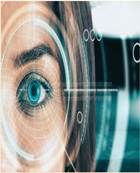An eye scanner that Boston University Medical School developed can detect molecular aging in people. The new technique provides an accurate measure of age-related damage and could, one day, play a role in routine clinical practice.
Everyone ages, but not in the same way. Two people of exactly the same age may be in very different states of health.
In other words, chronological age and biological age are different. But while chronological age is very easy to measure, biological age is more difficult to assess.
Although scientists know that there is wide variation in the processes of aging — for example, in the deterioration of cells and tissues — among individuals, there is currently no universally accepted measure of biological aging.
In a new study that appears in The Journals of Gerontology: Series A, researchers led by Boston University Medical School describe a tool that could fill this gap.
The researchers have developed a new eye scanner that detects molecular signatures of aging in the lens and is entirely noninvasive. Doctors could use it clinically to assess an individual’s aging process and then suggest personalized interventions.
The dearth of tools to assess aging accurately puts a limit on scientific understanding, senior author of the paper Dr Lee E. Goldstein explains.
“The absence of clinical tools and metrics to quantitatively evaluate how each person is aging at the molecular level represents a major impediment to understanding aging and maximizing health throughout life.”
The eyes are a good measure of aging because they contain cells that are generated in the fetus and not replaced. This means that the cells that a person is born with remain with them for life.
These cells are called primary fiber cells, and they occur in the lens, which focuses light onto the back of the eye. Incidentally, these cells also contain the highest concentration of protein in the human body.
SEDENTARY LIFESTYLE LINKED TO CANCER MORTALITY: A new study suggests that the total amount of time that people spend sitting is associated with a higher risk of death from cancer. Replacing some of this sedentary time with light physical activity appears to reduce the risk.
Getting regular physical activity is a proven way for people to lower their chance of developing cancer and dying from it.
The American Cancer Society recommends getting at least 150 minutes of moderate-to-vigorous physical activity each week.
In the 5 years after this, 268 participants (3.3%) died of cancer.
The researchers found that participants with the greatest total sedentary time had a 52% increased risk of dying from cancer compared with those who had the least sedentary time. However, there was notable uncertainty as to the exact size of the effect, with the best estimate ranging from a 1% to a 127% increased risk.










